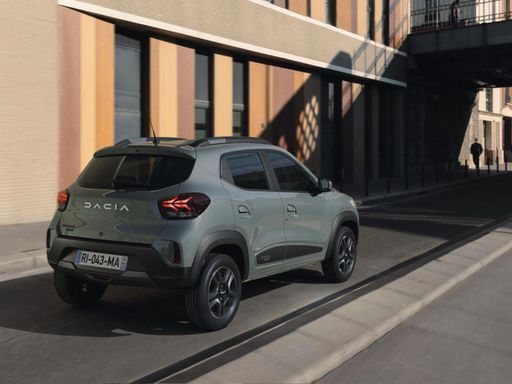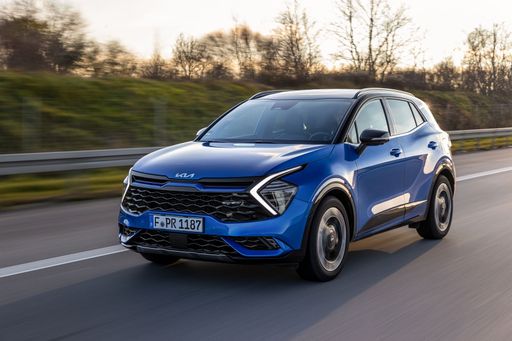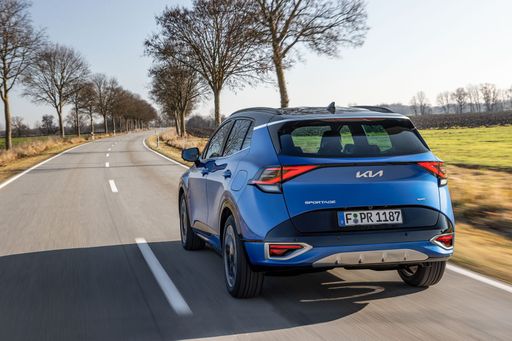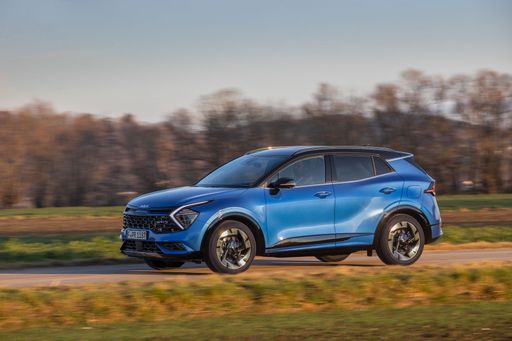Dacia Spring vs Kia Sportage – Differences & prices compared
Compare performance, boot space, consumption and price in one view.
Find out now: which car is the better choice for you – Dacia Spring or Kia Sportage?
The Dacia Spring (SUV) comes with a Electric engine and Automatic transmission. In comparison, the Kia Sportage (SUV) features a Diesel MHEV, Petrol MHEV, Full Hybrid, Petrol or Plugin Hybrid engine with Manuel or Automatic transmission.
When it comes to boot capacity, the Dacia Spring offers 308 L, while the Kia Sportage provides 587 L – depending on how much space you need. If you’re looking for more power, decide whether the 65 HP of the Dacia Spring or the 252 HP of the Kia Sportage suits your needs better.
In terms of consumption, the values are 13.20 kWh per 100 km for the Dacia Spring, and 1.20 L for the Kia Sportage.
Price-wise, the Dacia Spring starts at 14500 £, while the Kia Sportage is available from 29700 £. Compare all the details and find out which model fits your lifestyle best!
Dacia Spring
The Dacia Spring stands out as an affordable and environmentally friendly option in the electric vehicle market, combining practicality with a compact design ideal for urban settings. Its minimalist interior, while basic, provides all the essential features needed for a comfortable drive, reflecting its cost-effective approach. The vehicle's performance suits city driving, making it an appealing choice for those seeking an entry-level electric car.
details @ dacia-presse.de
@ dacia-presse.de
 @ dacia-presse.de
@ dacia-presse.de
 @ dacia-presse.de
@ dacia-presse.de
Kia Sportage
The Kia Sportage stands out in the crowded SUV market with its elegant design and advanced features. This vehicle offers a refined driving experience, combining comfort with responsive handling. Inside, the Sportage boasts a well-appointed cabin that provides ample space for passengers and luggage, making it an ideal choice for both city driving and longer journeys.
details @ press.kia.com
@ press.kia.com
 @ press.kia.com
@ press.kia.com
 @ press.kia.com
@ press.kia.com
 @ press.kia.com
@ press.kia.com

|

|
|
|
|
Costs and Consumption |
|
|---|---|
|
Price
14500 - 17100 £
|
Price
29700 - 44700 £
|
|
Consumption L/100km
-
|
Consumption L/100km
1.2 - 7.9 L
|
|
Consumption kWh/100km
13.2 - 14.1 kWh
|
Consumption kWh/100km
-
|
|
Electric Range
225 - 228 km
|
Electric Range
64 km
|
|
Battery Capacity
26.80 kWh
|
Battery Capacity
-
|
|
co2
0 g/km
|
co2
28 - 180 g/km
|
|
Fuel tank capacity
-
|
Fuel tank capacity
42 - 54 L
|
Dimensions and Body |
|
|---|---|
|
Body Type
SUV
|
Body Type
SUV
|
|
Seats
4
|
Seats
5
|
|
Doors
5
|
Doors
5
|
|
Curb weight
1013 - 1050 kg
|
Curb weight
1526 - 1905 kg
|
|
Trunk capacity
308 L
|
Trunk capacity
526 - 587 L
|
|
Length
3701 mm
|
Length
4515 - 4540 mm
|
|
Width
1583 mm
|
Width
1865 mm
|
|
Height
1519 mm
|
Height
1645 - 1650 mm
|
|
Payload
265 - 302 kg
|
Payload
510 - 580 kg
|
Engine and Performance |
|
|---|---|
|
Engine Type
Electric
|
Engine Type
Diesel MHEV, Petrol MHEV, Full Hybrid, Petrol, Plugin Hybrid
|
|
Transmission
Automatic
|
Transmission
Manuel, Automatic
|
|
Transmission Detail
-
|
Transmission Detail
Manual Gearbox, Dual-Clutch Automatic, Automatic Gearbox
|
|
Drive Type
Front-Wheel Drive
|
Drive Type
Front-Wheel Drive, All-Wheel Drive
|
|
Power HP
44 - 65 HP
|
Power HP
136 - 252 HP
|
|
Acceleration 0-100km/h
13.7 - 19.1 s
|
Acceleration 0-100km/h
7.9 - 11.6 s
|
|
Max Speed
125 km/h
|
Max Speed
180 - 203 km/h
|
|
Torque
113 - 125 Nm
|
Torque
250 - 350 Nm
|
|
Number of Cylinders
-
|
Number of Cylinders
4
|
|
Power kW
33 - 48 kW
|
Power kW
100 - 185 kW
|
|
Engine capacity
-
|
Engine capacity
1598 cm3
|
General |
|
|---|---|
|
Model Year
2024
|
Model Year
2024 - 2025
|
|
CO2 Efficiency Class
A
|
CO2 Efficiency Class
D, E, F, B, G
|
|
Brand
Dacia
|
Brand
Kia
|
Dacia Spring
The Revolution of Affordable Electric Mobility: The Dacia Spring
The automotive world has witnessed remarkable advancements in electric vehicles (EVs), with the Dacia Spring emerging as a noteworthy contender in the affordable segment. Combining efficiency, affordability, and practicality, the Spring offers an intriguing prospect for eco-conscious individuals and city dwellers alike.
Powertrain and Performance: A Look Under the Hood
The Dacia Spring is equipped with an electric motor that delivers between 44 to 65 PS, translating into a versatile driving experience tailored to urban landscapes. It operates on a front-wheel-drive system, ensuring a familiar and manageable handling experience.
Dacia Spring's electric engine is paired with an automatic transmission, utilising a reduction gearbox. This setup allows for smooth acceleration and a top speed of 125 km/h, ensuring that everyday driving scenarios are handled with ease.
Efficiency and Range: Eco-Friendly without Compromise
Efficiency is a cornerstone of the Dacia Spring's design, boasting an energy consumption of just 13.2 to 14.1 kWh per 100 km. When fully charged, its 26.8 kWh battery offers a respectable range of 225 to 228 km, making it ideal for daily commutes and short trips.
Furthermore, the Spring takes pride in its commendable CO2-efficiency class A, emphasising its commitment to reducing environmental footprint with a zero-emission profile.
Design and Practicality: Compact yet Comprehensive
Lying in the SUV category, the Dacia Spring is compact with dimensions of 3701 mm in length and 1583 mm in width, making it a perfect match for urban environments where space is at a premium. Despite its modest size, it provides a generous boot space of 308 litres, ensuring practicality isn’t sacrificed.
Comfort and Interior: For the Everyday Journey
The Dacia Spring comfortably seats up to four passengers. The cabin offers a minimalist yet functional design, available in multiple trim lines including Essential, Expression, and Extreme, allowing customers to choose according to their taste and requirement.
With its ergonomic layout and simplicity, the interior is crafted to enhance the driving experience by focusing on essential needs, avoiding unnecessary distractions.
Affordability and Accessibility: Breaking Barrier
The Dacia Spring stands out in the electric vehicle market due to its affordability, with prices ranging from 16,900 to 19,900 €. This ensures that environmentally friendly transportation is accessible to a broader audience.
Additionally, the Spring allows for cost-effective maintenance and operational expenses, offering monthly running costs between 570 to 599 € and cost per km between 22.8 to 24 cents, making it an economical choice in the long run.
Final Thoughts: The Future of Urban Mobility
In summary, the Dacia Spring serves as a testament to how electric vehicles can be both affordable and practical, without compromising on essential features. Whether it is for the eco-conscious urbanite or those looking for a cost-effective daily driver, the Spring is positioned as a viable solution for navigating the future of urban mobility.
Kia Sportage
The Kia Sportage: A Technological Masterpiece
The Kia Sportage has been a stalwart in the SUV segment, consistently offering excellent value, style, and performance. In its latest iteration, the Sportage pushes the boundaries with a fusion of advanced technology and innovative design, making it an enticing option for all types of drivers.
Power and Performance: The Heart of the Sportage
The new Kia Sportage boasts a broad range of powertrain options, ensuring there's something for everyone. Engines vary from efficient diesel mild-hybrids, petrol mild-hybrids, full hybrids, to cutting-edge plug-in hybrids. Output ranges from a nimble 136 PS to a robust 252 PS, providing a balance between efficiency and exhilarating performance.
The plug-in hybrid variant, in particular, sets new standards with an impressive electric range of 64 km, and a combined fuel consumption of merely 1.2 L/100km, positioning it as a leader in eco-friendly engineering.
Transmission and Drivetrain Advancements
The Sportage offers both manual and automatic transmission options, including advanced dual-clutch systems that ensure smooth and responsive gear shifts. Both front-wheel-drive and all-wheel-drive configurations are available, allowing the Sportage to handle diverse driving conditions with confidence.
A Sleek and Spacious Design
At 4515 mm long, the Sportage strikes a harmonious balance between offering a compact exterior for city driving while maximising interior space. With seating for five and a generous boot capacity ranging from 526 to 587 litres, the Sportage is designed with practicality in mind. The added benefit of a low aerodynamics-enhancing stance contributes to its efficiency and dynamic performance.
Innovative Features for the Modern Driver
Kia prioritises driver comfort and convenience in the Sportage, with the latest model featuring a suite of high-tech amenities. Depending on the trim, drivers can enjoy state-of-the-art infotainment systems, adaptive cruise control, and a range of safety technologies that earn high efficiency classifications, from B to F in CO2-efficiency class.
Pricing and Economy: Value for Every Penny
The Kia Sportage is available within a price range of €34,690 to €52,190, offering a cost-effective solution without compromising on quality or features. Monthly costs are optimised as well, ranging from €964 to €1,243, ensuring long-term savings alongside a lower environmental impact, with CO2 emissions between 28 to 162 g/km.
Conclusion: Why the Kia Sportage Stands Out
The Kia Sportage continues to solidify its position as a leading choice in the SUV market through its harmonious blend of technology, performance, and practicality. With such a wide range of configurations and trims, it caters to various needs, making it a versatile and intelligent investment for the environmentally conscious and the performance enthusiast alike. Whether for urban adventures or rural expeditions, the Sportage promises a journey defined by comfort, reliability, and innovation.
Which drive types are available for the Dacia Spring?
Available as Front-Wheel Drive.
The prices and data displayed are estimates based on German list prices and may vary by country. This information is not legally binding.
